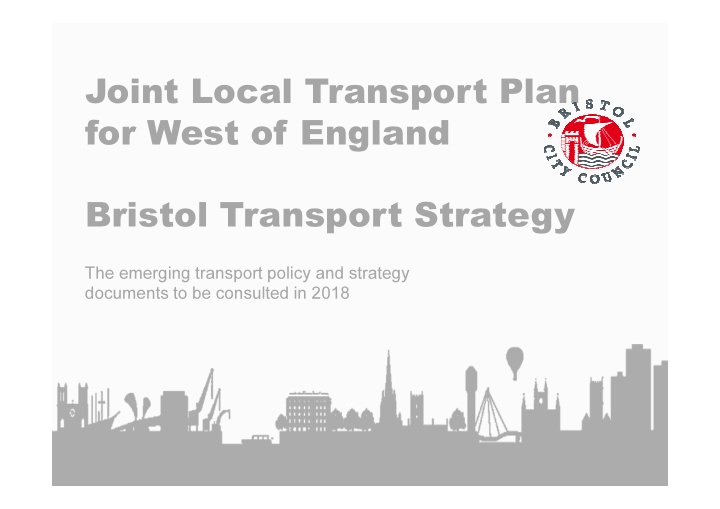



Joint Local Transport Plan for West of England Bristol Transport Strategy The emerging transport policy and strategy documents to be consulted in 2018
Joint Local Transport Plan sets out the transport vision for the West of England for the next 20 years, which includes measures Joint Spatial Plan sets out locations for identified in the Joint Transport Study and housing and job growth across West of more England for next 20 years (see these symbols on the map) Joint Transport Study completed in 2017 identified the transport requirements to connect new housing and jobs (as shown on the map) Bristol Transport Strategy focuses the JLTP down to city level and sets out the transport vision for Bristol for the next 20 years
Joint Spatial Plan (JSP)- housing and Joint Transport Study (JTS) identified mitigating jobs and mitigating transport transport measures for housing and jobs and measures to 2036 overall transport vision to 2036 Local Cycling and Walking Key Route Network West of England Bus Infrastructure Plan (LCWIP) (KRN)- separate to but Strategy- separate to separate to but supports supports JLTP but supports JLTP JLTP and local plans and strategies Joint Local Transport Plan (JLTP)- Produced by West of policies and actions to achieve transport vision to 2036 England (with input from WoE authorities) Bristol Transport Strategy (BTS)- Bristol Clean Air Strategy- separate to outcomes and actions to achieve but informs BTS Bristol Local Plan- will Bristol’s transport vision to 2036 contain references to BTS, Clean Air Strategy and land Produced by Bristol safeguarded for wider Various transport mode, topic schemes identified in JLTP and location specific strategies and LCWIP and plans, mostly to begin in 2019
Joint Spatial Plan (JSP) delivery (homes and jobs and transport mitigation measures) Period that Joint Local Transport Plan (JLTP) covers, which includes JSP transport mitigations Period that Local Cycling and Walking Infrastructure Plan (LCWIP) and Bus Strategy and Key Route Network (KRN) cover Period that Bristol Transport Strategy covers, which includes JLTP, LCWIP, Bus Strategy and KRN measures that affect Bristol 2018 2036 From 2019: mode and topic specific plans and strategies to be developed and consulted on, e.g. Bristol Walking Strategy, Bristol Cycling Strategy, Bristol Parking Strategy
JLTP • Statutory sub-regional plan • WECA and N Somerset • Contains strategies that affect movement across the sub-region • Contains major transport schemes (from Joint Transport Study)
JLTP • Objectives: • Support sustainable economic growth • Promote equality and accessibility • Improve air quality and respond to climate change • Contribute to better health, wellbeing, safety and security • Structure: Improving connectivity- • Beyond the West of England • Within the West of England • Neighbourhoods and Local
JLTP
JLTP • Major schemes from Joint Transport Study, including: • Mass transit • Greater Bristol Bus Network 2 • Park and Ride • Walking and Cycling network • MetroWest rail • Cost of schemes identified in the plan: £10bn • Funding gap- suggested measures to fund schemes to be tested in public consultation include road user charging, workplace parking levy, business rate supplements, council tax precept
Bristol Transport Strategy • First of its kind • Fills gap between West of England Joint Local Transport Plan and mode/topic specific strategies • Provides a framework for transport policy in Bristol • Written in partnership with Mayor’s Congestion Task Group
Bristol Transport Strategy • Vision: ‘Our vision for Bristol is to be a well-connected city that enables people to move around efficiently with increased transport options that are accessible and inclusive to all. We will deliver an improved sustainable and resilient transport network that that supports Bristol’s vibrant independent local centres and neighbourhoods and connects to an attractive and thriving city centre.’
Bristol Transport Strategy • Objectives: • Provide transport improvements to accommodate increased demand from growth in housing, jobs & regeneration on an already congested network with complex movements from within and outside the city boundary. • Promote equality with an inclusive transport system that provides realistic transport options for all. • Create healthy places , promoting active transport, improving air quality, and implementing a safe systems approach to road safety. • Create better places that make better use of our streets and enable point to point journeys to be made efficiently. • Enable reliable journeys by minimising the negative impacts of congestion and increasing network efficiency and resilience. • Support sustainable growth by enabling efficient movement of people and goods, reducing carbon emissions and embracing new technologies
Bristol Transport Strategy Structure: • City Wide movement • City Centre • Corridors • Local Centres • Neighbourhoods and Residential Streets • Implementation and funding plan
Bristol Transport Strategy • Sets out our approach to implementing actions • Where appropriate, states who we will work with • Major transport schemes in JLTP that effect Bristol • Includes road user charging and workplace parking levy as funding mechanism to gain feedback in consultation
Public consultation • Due to go out in October 2018 together • Methods include: • Videos to explain context of each plan • Budget simulator tool (JLTP measures) • Online questionnaires • Materials to be put in public centres to direct to website • Social media toolkits • Stakeholder events
Recommend
More recommend